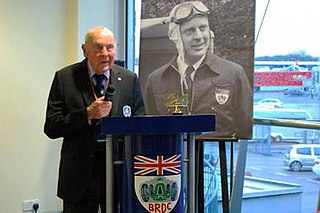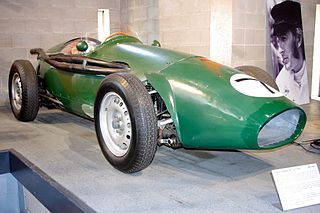
Allard Motor Company Limited was a London-based low-volume car manufacturer founded in 1945 by Sydney Allard in small premises in Clapham, south-west London. Car manufacture almost ceased within a decade. It produced approximately 1900 cars before it became insolvent and ceased trading in 1958. Before the war, Allard supplied some replicas of a Bugatti-tailed special of his own design from Adlards Motors in Putney.

Formula Three, also called Formula 3, abbreviated as F3, is a third-tier class of open-wheel formula racing. The various championships held in Europe, Australia, South America and Asia form an important step for many prospective Formula One drivers.

The Porsche 804 is a single-seat, open-wheeled racing car produced by Porsche to compete in Formula One (F1). It raced for a single season in 1962 in the 1½ litre formula.
The Alta Car and Engineering Company was a British sports and racing car manufacturer, commonly known simply as Alta. Their cars contested five FIA World Championship races between 1950 and 1952, as well as Grand Prix events prior to this. They also supplied engines to a small number of other constructors, most notably the Connaught and HWM teams.

Ferrari America is a series of top-end Ferrari models built in the 1950s and 1960s. They were large grand touring cars with the largest V12 engines and often had custom bodywork. All America models used a live axle in the rear, were front-engined, and had worm and sector steering.

Lea-Francis was a British motor manufacturing company that began by building bicycles.

English Racing Automobiles (ERA) was a British racing car manufacturer active from 1933 to 1954.

Connaught Engineering, often referred to simply as Connaught, was a Formula One, Formula Two and sports car constructor from the United Kingdom. Their cars participated in 18 Grands Prix, entering a total of 52 races with their A, B, and C Type Formula 2 and Formula 1 Grand Prix Cars. They achieved 1 podium and scored 17 championship points. The name Connaught is a pun on Continental Autos, the garage in Send, Surrey, which specialised in sales and repair of European sports cars such as Bugatti, and where the cars were built.

Eric David Thompson was a British racing driver, book dealer and insurance broker. He participated in sports car racing between 1949 and 1955 taking his greatest success by finishing third in the 1951 Les 24 Heures du Mans and took part in the 1952 RAC British Grand Prix.

The Ferrari 500 was a Formula 2 racing car designed by Aurelio Lampredi and used by Ferrari in 1952 and 1953, when the World Championship was run to F2 regulations.

After finding only modest success with the supercharged 125 F1 car in Formula One, Ferrari decided to switch for 1950 to the naturally aspirated 4.5-litre formula for the series. Calling in Aurelio Lampredi to replace Gioacchino Colombo as technical director, Enzo Ferrari directed that the company work in stages to grow and develop an entirely new large-displacement V12 engine for racing.

The Maserati Tipo 151 is a racing car manufactured by Italian automobile manufacturer Maserati for the 1962 LeMans season to compete in the experimental GT car class. Three cars were built in total, one for Johnny Simone of Maserati France with a red exterior colour and white tri-stripes whilst two were built for Briggs Cunningham for his racing team. These cars had a white body with two blue stripes.
Davidstow Circuit is a disused motor racing circuit and airfield built in Cornwall, in the United Kingdom. The circuit was built on the site of a World War II RAF Coastal Command base, RAF Davidstow Moor, opened in 1942. Davidstow circuit opened in 1952, and held three Formula 1 races between 1954 and 1955. The circuit hosted its last race in 1955, and was one of many of Britain's airfields to be transformed into motor racing venues. Davidstow circuit is notable for the first victory in a Formula One race by a Lotus.

The Cooper Mark IV was a Formula Three, Formula Two and Formula One racing car designed and built by the Cooper Car Company at Surbiton, Surrey, England, in 1950.
The B. S. Cunningham Company was an automobile company established by Briggs Cunningham. It produced six different models in very small numbers, primarily to be raced at the 24 Hours of Le Mans.

The Cooper T39, nicknamed the "Bob-Tail", is a successful lightweight, mid-engined, sports car, designed and developed by Owen Maddock at Cooper Cars, for sports car racing in 1955. The car debuted in active racing competition at the Easter race in Thruxton in 1955, being driven by Ivor Bueb, and was later entered into the 1955 24 Hours of Le Mans, being driven by John Brown and Edgar Wadsworth, but was unfortunately not classified, because even though the car managed to complete 207 laps around the 8.4-mile Le Mans circuit, it didn't manage to finish within 70% of the winners' race distance. However, between 1956 and 1962, it did manage to rack up and tally an incredible streak of domination and competitiveness, scoring 91 total wins and clinching 236 podiums finishes; an incredible record. It was powered by the 1,098 cc (67.0 cu in) Coventry-Climax four-cylinder engine.

The Ferrari 166 FL was a single-seat open-wheel race car, designed, developed and built by Italian manufacturer and team, Scuderia Ferrari, 1949 to 1952. Only three cars were produced. The designation 166 refers to the (rounded) displacement of a single cylinder, which corresponded to the nomenclature of the company at the time. The abbreviation FL stands for Formula Libre, which is the type of category and racing series that the car competed in. Since the car was mainly developed for racing in South America, it was also known as the 166 C America.
The Cooper T76 is an open-wheel Formula 3 race car, designed, developed and built by British manufacturer Cooper in 1965. It was powered by either a 1.0 L (61 cu in) Cosworth MAE or BMC naturally-aspirated four-cylinder engine, which drove the rear wheels through a Hewland Mk5/6 manual transmission. It also featured reworked front and rear suspension, as well as variable anti-roll bars. Chassis design and construction was a tubular space frame. The car was essentially a modified variant of the previous T72. The rocker arm leverage ratio at the front of the car was altered from 2:1 to 1:3 to aid in the location and life of the shock absorber. The "anti-squat" system out of the rear suspension, and variable Armstrong shocks were installed. Rear-facing radius rods were linked to the front rocker arms to mitigate the forces felt under braking.

The Connaught Type B was a racing car made by Connaught Engineering of England used in Formula One racing between 1955 and 1958. Although not a success in the Formula One World Championship, it became the first British car since 1924 to win a Continental European motor race when Tony Brooks won the non-championship 1955 Syracuse Grand Prix.















